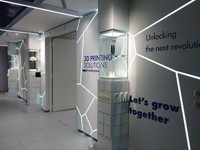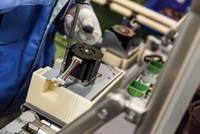Advertisement
Grab your lab coat. Let's get started
Welcome!
Welcome!
Create an account below to get 6 C&EN articles per month, receive newsletters and more - all free.
It seems this is your first time logging in online. Please enter the following information to continue.
As an ACS member you automatically get access to this site. All we need is few more details to create your reading experience.
Not you? Sign in with a different account.
Not you? Sign in with a different account.
ERROR 1
ERROR 1
ERROR 2
ERROR 2
ERROR 2
ERROR 2
ERROR 2
Password and Confirm password must match.
If you have an ACS member number, please enter it here so we can link this account to your membership. (optional)
ERROR 2
ACS values your privacy. By submitting your information, you are gaining access to C&EN and subscribing to our weekly newsletter. We use the information you provide to make your reading experience better, and we will never sell your data to third party members.
Materials
Chemical firms plunge into 3-D printing
An increasing number of companies are dedicating efforts to the emerging polymer technology
by Alexander H. Tullo
November 14, 2017
| A version of this story appeared in
Volume 95, Issue 46

Polymer companies including Arkema, DSM, Lubrizol, and Perstorp are deepening their commitment to three-dimensional printing. They are betting that increasing the number of materials available for the technology will help it take off in manufacturing.
DSM has established a new business, DSM Additive Manufacturing, as part of an effort to broaden its 3-D printing business beyond stereolithography (SLA), a process that uses lasers to trace parts out of a vat of photopolymer. A leader in that sector for decades, DSM now aims to sell polymers for other 3-D printing techniques, including fused filament fabrication (FFF), in which a machine draws parts layer by layer with melted resin.
“SLA is our heritage,” says Hugo da Silva, DSM’s vice president of additive manufacturing. “However, we can play in all polymer printing technologies.”
At the Formnext 2017 trade show, which takes place this week in Germany, DSM is exhibiting two resins for FFF. One is a nylon intended for industrial applications such as fuse boxes, electronic housings, and connectors. The other is a thermoplastic copolyester elastomer that boasts heat and chemical resistance and can be used in under-the-hood automotive applications.
The company also acquired a materials development kit from the printer giant HP, which is developing a high-speed 3-D printing technology it calls Multi Jet Fusion. The kit will allow DSM to test the compatibility of its resins with HP’s process. Dow Chemical also acquired a toolkit.
Materials, HP argues, are essential to the success of 3-D printing. Ramon Pastor, general manager of Multi Jet Fusion at HP, points out that thousands of materials are available for conventional “analog” processes such as injection molding. “3-D printing will need to develop just as many,” he says.
Earlier this month, Lubrizol signed up for HP’s open materials and applications program, joining giants like Arkema, BASF, and Evonik Industries, which have been testing materials at HP’s lab in Corvallis, Ore. Lubrizol will soon test its Estane thermoplastics polyurethane elastomers.
At the Formnext show, HP highlighted a new machine, the Jet Fusion 3D 4210, which it says can print parts 65% more cheaply than other technologies.
And unlike 3-D printers that are best suited for prototyping and other small-volume applications, the HP machine can make up to 110,000 parts less expensively than traditional injection molding, the company says. Its previous generation of machine was competitive with injection molding up to 50,000 parts.
In addition to its collaboration with HP, Arkema is working with EOS, a German firm whose printers make parts by sintering resin powder with a laser. For EOS machines, Arkema has developed a grade of polyetherketoneketone, which has high-temperature properties that make it suitable for replacing metal parts.
Similarly, Swedish chemical maker Perstorp is collaborating with 3-D printing filament provider 3D4Makers to develop Facilan-brand filament for FFF. Perstorp isn’t disclosing the chemistry behind Facilan, but the company is a leader in caprolactone-based polymers.
Perstorp claims that Facilan is stronger than acrylonitrile-butadiene-styrene, a popular resin used in FFF 3-D printing when good mechanical properties are needed, and that it processes better than polylactic acid, a plastic known for being easy to use in 3-D printers.




Join the conversation
Contact the reporter
Submit a Letter to the Editor for publication
Engage with us on Twitter